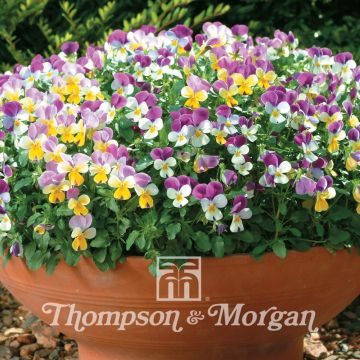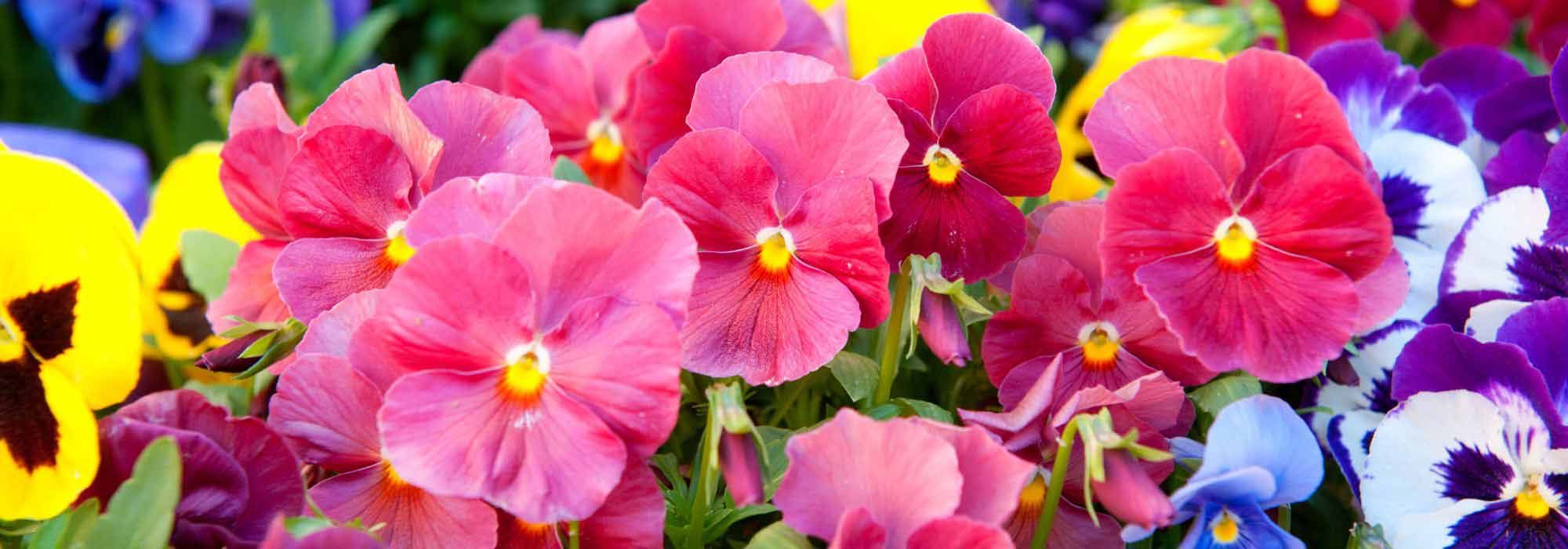

Graines de Viola Tricolore Heartsease - Pensée sauvage
Viola tricolor
Viola tricolor Tricolore Heartsease
Garden Pansy
This little half-wild pansy is becoming hard to find in the everyday hustle and bustle. Thank you for keeping it alive.
Claude, 07/09/2019
Special offer!
Receive a €20 voucher for any order over €90 (excluding delivery costs, credit notes, and plastic-free options)!
1- Add your favorite plants to your cart.
2- Once you have reached €90, confirm your order (you can even choose the delivery date!).
3- As soon as your order is shipped, you will receive an email containing your voucher code, valid for 3 months (90 days).
Your voucher is unique and can only be used once, for any order with a minimum value of €20, excluding delivery costs.
Can be combined with other current offers, non-divisible and non-refundable.
Why not try an alternative variety in stock?
View all →This plant carries a 6 months recovery warranty
More information
We guarantee the quality of our plants for a full growing cycle, and will replace at our expense any plant that fails to recover under normal climatic and planting conditions.
Would this plant suit my garden?
Set up your Plantfit profile →
Description
Sought after for the delicacy of its flower, Viola tricolor, also known as Heartsease, is a small annual or biennial plant from which the cultivated pansy descends, bravely braving the harshness of winter to decorate our gardens. From summer to winter, it tirelessly displays its hand-painted corollas, which can be blue, white, yellow, and violet, each flower having its own personality. Over time, it forms a beautiful carpet of leaves and flowers and self-seeds abundantly in fresh, well-drained soil in the sun.
Belonging to the violet family, Viola tricolor, or wild pansy, grows spontaneously in many regions of temperate Europe and Asia. It is a low perennial plant that has given rise to many hybrids, the most famous of which are garden pansies. It is a herbaceous ground-covering plant, reaching a height of 15cm (6in) when in flower. Its dark green, ovate, and lobed evergreen leaves form a spreading tuft with a somewhat creeping habit. It can sometimes be perennial, but most often biennial. Depending on the sowing date, this plant flowers from spring to winter, sometimes continuously if pruned at the end of summer. Its solitary and lateral flowers, carried on long peduncles, appear on aerial stems. The sepals are never larger than the corolla, which is 10 to 25mm (0.3 to 1in) long. It can be violet, purple, blue, yellow, or white. The tricolour form, yellow, white, and violet, is the most sought after and gives the species its name. The entire flower measures about 15mm (1in) in diameter, and the petals have a silky texture that reflects light well. The angular, branched stems bear ovate, lobed, or lanceolate leaves. This plant spreads quite rapidly thanks to its rhizomes and also self-seeds very easily in the garden.
Horned violets and tricolour pansies are intended for low flower beds, borders, as well as pots and balcony planters, where they will be associated with other spring and summer flowering plants (Forget-me-nots, Dwarf daffodils, Daisies, Primroses, Botanical tulips, summer and autumn asters, etc.). The flowers of violets and pansies are edible, so don't hesitate to decorate your plates with one or two flowers, or even add some to your salads to give them a touch of colour.
Flowering
Foliage
Plant habit
Botanical data
Viola
tricolor
Tricolore Heartsease
Violaceae
Garden Pansy
Cultivar or hybrid
Other Pansy seeds
View all →Planting and care
Sow the wild pansy in a nursery from July to September and then transplant the young plants into pots. Install your young plants in October before the first frosts, spacing them 20cm (8in) apart, in open ground.
Second option: sow under cover at the end of winter and plant the seedlings in open ground at the end of spring.
Germination takes about 15 days at 16°C (60.8°F).
Use a compound mixture of 1/3 compost, 1/3 garden soil, and 1/3 river sand. It takes 15 days for the seedlings to appear. Watch out for attacks from snails and slugs, as they are fond of these young plants.
Removing faded flowers will promote the renewal of flowering.
Wild pansies appreciate a light, humus-rich soil that is moist but well-drained, as they are sensitive to excess moisture in winter. In heavy soil, add some sand to improve drainage.
Plant the pansies in a sunny location, but not in direct sunlight or under light shade.
Sowing period
Intended location
Planting & care advice
-
, onOrder confirmed
Reply from on Promesse de fleurs
Similar products
Haven't found what you were looking for?
Hardiness is the lowest winter temperature a plant can endure without suffering serious damage or even dying. However, hardiness is affected by location (a sheltered area, such as a patio), protection (winter cover) and soil type (hardiness is improved by well-drained soil).

Photo Sharing Terms & Conditions
In order to encourage gardeners to interact and share their experiences, Promesse de fleurs offers various media enabling content to be uploaded onto its Site - in particular via the ‘Photo sharing’ module.
The User agrees to refrain from:
- Posting any content that is illegal, prejudicial, insulting, racist, inciteful to hatred, revisionist, contrary to public decency, that infringes on privacy or on the privacy rights of third parties, in particular the publicity rights of persons and goods, intellectual property rights, or the right to privacy.
- Submitting content on behalf of a third party;
- Impersonate the identity of a third party and/or publish any personal information about a third party;
In general, the User undertakes to refrain from any unethical behaviour.
All Content (in particular text, comments, files, images, photos, videos, creative works, etc.), which may be subject to property or intellectual property rights, image or other private rights, shall remain the property of the User, subject to the limited rights granted by the terms of the licence granted by Promesse de fleurs as stated below. Users are at liberty to publish or not to publish such Content on the Site, notably via the ‘Photo Sharing’ facility, and accept that this Content shall be made public and freely accessible, notably on the Internet.
Users further acknowledge, undertake to have ,and guarantee that they hold all necessary rights and permissions to publish such material on the Site, in particular with regard to the legislation in force pertaining to any privacy, property, intellectual property, image, or contractual rights, or rights of any other nature. By publishing such Content on the Site, Users acknowledge accepting full liability as publishers of the Content within the meaning of the law, and grant Promesse de fleurs, free of charge, an inclusive, worldwide licence for the said Content for the entire duration of its publication, including all reproduction, representation, up/downloading, displaying, performing, transmission, and storage rights.
Users also grant permission for their name to be linked to the Content and accept that this link may not always be made available.
By engaging in posting material, Users consent to their Content becoming automatically accessible on the Internet, in particular on other sites and/or blogs and/or web pages of the Promesse de fleurs site, including in particular social pages and the Promesse de fleurs catalogue.
Users may secure the removal of entrusted content free of charge by issuing a simple request via our contact form.
The flowering period indicated on our website applies to countries and regions located in USDA zone 8 (France, the United Kingdom, Ireland, the Netherlands, etc.)
It will vary according to where you live:
- In zones 9 to 10 (Italy, Spain, Greece, etc.), flowering will occur about 2 to 4 weeks earlier.
- In zones 6 to 7 (Germany, Poland, Slovenia, and lower mountainous regions), flowering will be delayed by 2 to 3 weeks.
- In zone 5 (Central Europe, Scandinavia), blooming will be delayed by 3 to 5 weeks.
In temperate climates, pruning of spring-flowering shrubs (forsythia, spireas, etc.) should be done just after flowering.
Pruning of summer-flowering shrubs (Indian Lilac, Perovskia, etc.) can be done in winter or spring.
In cold regions as well as with frost-sensitive plants, avoid pruning too early when severe frosts may still occur.
The planting period indicated on our website applies to countries and regions located in USDA zone 8 (France, United Kingdom, Ireland, Netherlands).
It will vary according to where you live:
- In Mediterranean zones (Marseille, Madrid, Milan, etc.), autumn and winter are the best planting periods.
- In continental zones (Strasbourg, Munich, Vienna, etc.), delay planting by 2 to 3 weeks in spring and bring it forward by 2 to 4 weeks in autumn.
- In mountainous regions (the Alps, Pyrenees, Carpathians, etc.), it is best to plant in late spring (May-June) or late summer (August-September).
The harvesting period indicated on our website applies to countries and regions in USDA zone 8 (France, England, Ireland, the Netherlands).
In colder areas (Scandinavia, Poland, Austria...) fruit and vegetable harvests are likely to be delayed by 3-4 weeks.
In warmer areas (Italy, Spain, Greece, etc.), harvesting will probably take place earlier, depending on weather conditions.
The sowing periods indicated on our website apply to countries and regions within USDA Zone 8 (France, UK, Ireland, Netherlands).
In colder areas (Scandinavia, Poland, Austria...), delay any outdoor sowing by 3-4 weeks, or sow under glass.
In warmer climes (Italy, Spain, Greece, etc.), bring outdoor sowing forward by a few weeks.































































